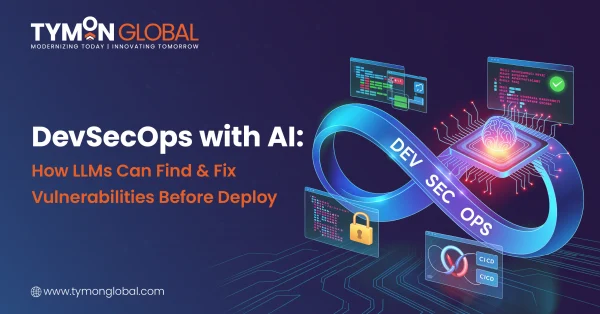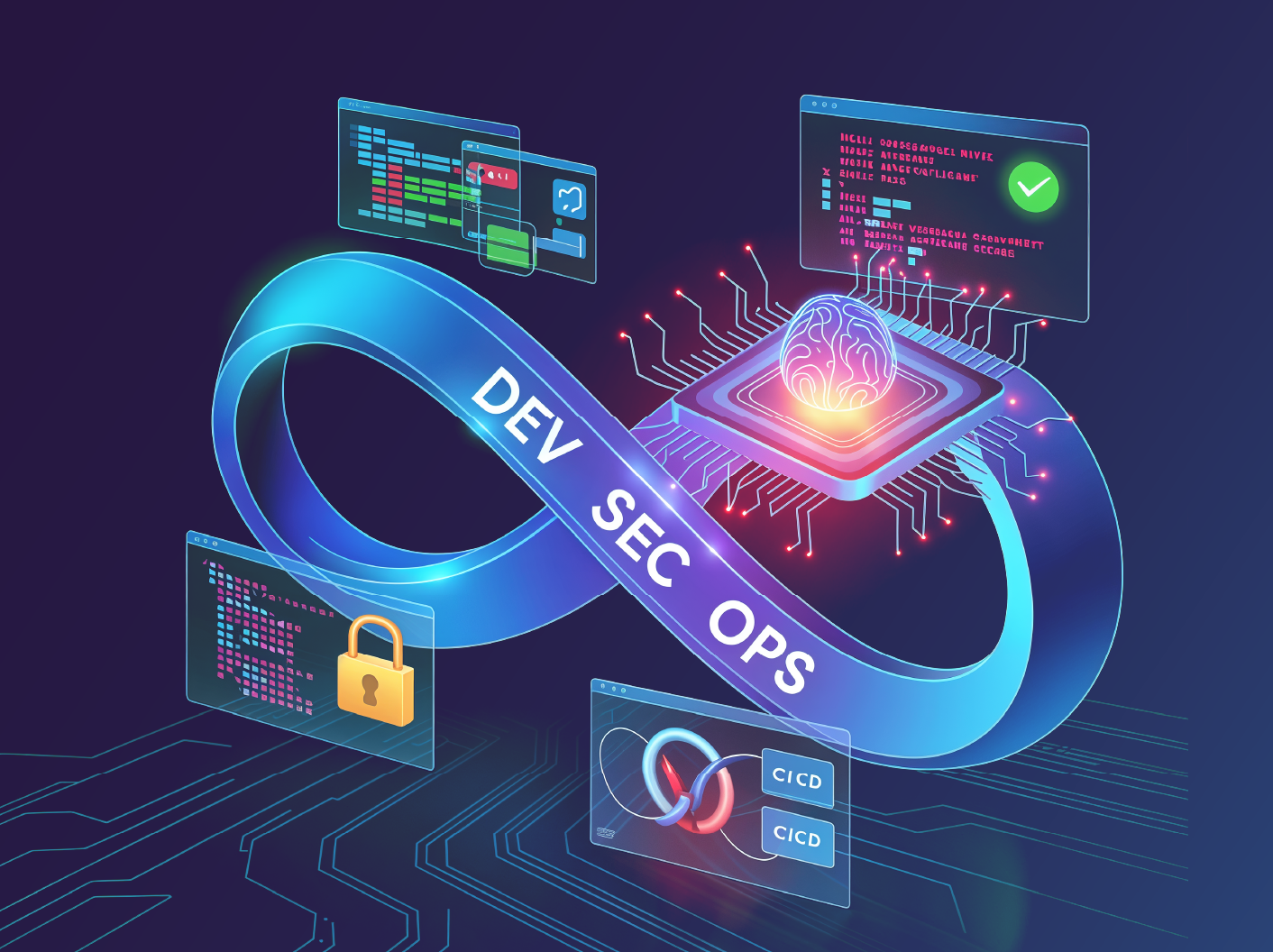
As enterprises speed their digital transformation, AI for application security becomes a major issue before deployment in a more complex context. DevSecOps with AI and LLMs makes vulnerabilities easier to find and fix. Microservices, EDA, and API-based designs are changing the software development pipeline security.
Rapid use of event-driven designs, API-centric systems, and microservices complicates business contexts. Microservices output is expected to grow 250% globally in three years. This suggests a quick shift to software frameworks that are adaptable and scalable. This change raises security risks since hackers are focusing on API endpoints.
The vulnerability of APIs as the foundation of contemporary corporate platforms is illustrated by the fact that over 60% of firms reported security vulnerabilities when utilising APIs in the past year.
This blog discusses how Tymon Global uses AI with CI/CD pipelines to improve security and provide continuous vulnerability checks during development.
The DevSecOps Imperative in Modern Business Architectures
Digital transformation favours microservices and event-driven architectures (EDA). Distributed systems improve application speed, flexibility, and scalability, but bring new security risks. APIs connect microservices, unlike monolithic apps, insecure APIs may threaten the ecosystem.
Security used to be added near the end of development, usually during testing or deployment. This reactive method is no longer useful because threats are always changing. As security breaches become more complex and widespread, DevSecOps lets firms add security to their DevOps workflow.
DevSecOps is an addition to DevOps that adds security to every step of the development process. Early-stage security helps companies find and fix problems before they release software. Microservices and other complex architectures make security harder to set up, though. Here, AI-powered technologies, especially LLMs, are quite important.
Leveraging LLMs to Detect and Address Security Vulnerabilities in Real-Time
Advanced GPT-based Large Language Models (LLMs) can analyse enormous security protocols, system configurations, and source code datasets. The development process can use these models for real-time vulnerability identification. Their code reading skills allow them to uncover even the smallest security issues that static analysis misses.
LLMs bring multiple capabilities that are crucial for enhancing security in Microservices and EDA environments:
- Automatic Code Review: LLMs uncover common API and microservice security concerns. This technique prevents SQL injection, XSS, and incorrect access control before production. Without rate limiting or authentication, attackers can abuse APIs, but LLMs can identify flaws.
- Real-Time Vulnerability Detection: LLMs can scan code for vulnerabilities in real time since they can process enormous amounts of data. This helps CI/CD pipeline developers. LLMs find vulnerabilities as they are written, allowing teams to repair them before sending code.
- Contextual Understanding: LLMs evaluate code context, unlike static code analysis techniques that use patterns to find problems. This helps them find syntax errors, logic errors, incorrect design decisions, and unnecessary microservice interactions that could compromise security, improving security recommendations.
- Automatic corrections and suggestions: LLMs identify issues and offer solutions. If an API endpoint is insecure, the AI in a secure software development model may recommend OAuth for authentication or encryption for sensitive data transfer. Developers may quickly fix security issues, saving time.
- Integration with CI/CD processes: LLM-powered AI models can be easily integrated into CI/CD workflows for continuous security checks. Tymon Global, a renowned CI/CD service provider, uses AI to check new code for vulnerabilities automatically. In real time, AI-driven systems may detect dangers in new or changed code, preventing security gaps.
Integrating with AI Consulting Services for Business Growth, like Tymon Global, adopts innovative security solutions early in the development lifecycle to enable organisations to develop quickly without compromising security. This integration secures software before release, preventing security risks.
Securing APIs in Microservices Architectures with AI-Powered Tools
Microservices architectures have hundreds or thousands of APIs, making manual security onerous. Traditional methods like manual auditing and human interaction are insufficient in complicated systems. Malicious actors routinely exploit modern software vulnerabilities through APIs.
Automation is needed after API breaches, where Verizon revealed that API vulnerabilities caused 67% of data breaches in 2023, underlining the need to secure infrastructure access points. API security services are a significant enterprise priority as Microservices architectures get more complicated. LLMs can quickly process and analyse API code, solving this development issue.
AI-driven API security technologies help enterprises in many ways:
- API Scanning and Threat Detection: LLMs can uncover weaknesses, such as insufficient authentication, encryption, and API key management, during API scanning and threat detection. Automatic API endpoint scanning reduces breach risk.
- Behavioral Anomaly Detection: LLMs detect API traffic anomalies. AI models can alert users to attacks by detecting suspicious API calls from unfamiliar sources or strange API access rates.
- Securing Third-Party Integrations: APIs often integrate with third-party services, increasing vulnerability. LLM security tools can examine third-party integrations for security best practices, decreasing external dependency concerns.
Event-Driven Architectures and AI: A Powerful Combination for Securing Distributed Systems
Businesses are adopting Event-Driven Architectures (EDA) to increase real-time data processing and responsiveness. Events—state or data changes that cause system responses—drive EDAs. This architecture improves scalability and performance but complicates security. Multiple asynchronous services make it difficult to track and secure every contact. LLMs can protect the following event-driven architectures:
- Real-Time Event Monitoring: LLMs employ AI to detect suspicious or damaging events, assess event content and context for unauthorised access or activity, and trigger security responses.
- Automated Event Validation: AI-powered systems can validate events before other services process them, which prevents disruptions and breaches from harmful occurrences.
- Event Correlation and Threat Detection: LLMs can expose hidden attack patterns by correlating service events. This helps organizations recognize threats and act before they cause damage.
Why Tymon Global is Your Ideal Partner for AI-Driven DevSecOps Solutions
Tymon Global understands the need to protect complex, dispersed business systems. As a leading digital transformation and IT services provider, we offer DevSecOps, AI, and Microservices solutions for secure software development.
As API security, Microservices architecture, and Event-Driven Architecture experts, we are the best partner for enterprises looking to upgrade their security policies. We use AI-driven LLM-enabled solutions to secure your apps from the start, eliminating vulnerabilities and speeding up time-to-market.
Tymon Global’s specialists work with clients to create, implement, and maintain bespoke security solutions. We have the ability and experience to ensure your systems are secure, scalable, and high-performing when you transition from traditional ERP systems to Microservices or embrace an agile, event-driven approach.
A Proactive Approach to Security with AI and DevSecOps
AI-powered technologies like LLMs in DevSecOps help companies detect and resolve issues early. This allows the companies to avoid costly security breaches. There is no longer a requirement for expensive security breaches, which makes this thing viable. These days, developers have access to the tools they require to design systems that are secure and robust.
This is regardless of whether they are working with API management, Event-Driven Architectures, or Microservices technologies. The construction of systems requires both of these technologies to be successful. It is the implementation of artificial intelligence that makes the possibility of this technology realistic. Tymon Global can aid your firm in achieving digital transformation and protecting its future development by utilizing its knowledge and advanced technologies. This assistance can be provided to your organization.
If you’re ready to elevate your DevSecOps practices with AI, contact us today to learn how we can help you achieve secure, scalable, high-performance solutions.
Frequently Asked Questions
Q. What is DevSecOps, and how does it enhance security?
DevSecOps integrates security into the development pipeline, ensuring vulnerabilities are detected early and fixed before deployment. This proactive approach reduces risks and enhances overall software security.
Q. How do AI-powered tools improve security in CI/CD pipelines?
AI-powered tools, such as those based on Large Language Models (LLMs), scan code in real-time within CI/CD pipelines, detecting vulnerabilities early. This automated security check prevents breaches and improves efficiency in the development process.
Q. What is the role of APIs in Microservices security?
APIs are critical in Microservices for communication between services. Securing APIs is essential to prevent attacks. AI-driven security tools can scan APIs for vulnerabilities like improper authentication or encryption flaws, safeguarding the entire system.
Q. How does AI detect vulnerabilities in Microservices and Event-Driven Architecture?
AI models, like LLMs, analyze code interactions within Microservices and Event-Driven Architectures, detecting vulnerabilities such as logic flaws, insecure APIs, or improper access control, allowing teams to address security issues in real-time.
Q. Why is AI-driven DevSecOps crucial for businesses?
AI-driven DevSecOps enables continuous, automated security checks during development, helping businesses catch vulnerabilities before deployment. This approach enhances security, accelerates the development lifecycle, and reduces the risks of cyberattacks.

